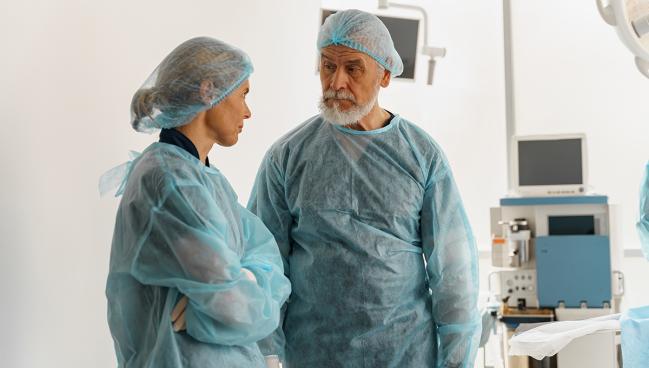CABG and PCI Comparable in ACS Patients With Left Main CAD
The results line up with an all-comers analysis and point to an evolving understanding of how to treat LM CAD, say experts.

Patients with left main coronary artery disease who present with ACS fare just as well when treated with PCI as they do with CABG surgery, according to results of a new study.
While ACS patients had higher rates of all-cause and cardiovascular mortality at 30 days than those without ACS, there was no difference in the risk of death at 5 years based on how they were revascularized, report investigators.
The focused look at ACS patients follows the original meta-analysis looking at left main CAD more broadly.
“Reassuringly, despite the fact that they are a higher-risk group, which, in general, would tend to favor surgery, overall things look pretty consistent with the primary meta-analysis findings,” senior investigator Brian Bergmark, MD (Brigham and Women’s Hospital, Boston, MA), told TCTMD.
In the meta-analysis as a whole, no difference in the risk of all-cause mortality at 5 years among patients with left main CAD treated with PCI or CABG surgery. Rates of spontaneous MI and coronary revascularization were higher with PCI, and while there no significant difference in the risk of stroke at 5 years, the stroke rate was lower with PCI in the first year.
That study, which was published in 2021, was requested by the European Society of Society (ESC) so they could review the evidence around the relative risks and benefits of PCI and CABG surgery in left main disease, an area of medicine that went radioactive several years back. The controversy began with the 5-year data from EXCEL and culminated in the European Association for Cardio-Thoracic Surgery (EACTS) withdrawing their support from the left main section of the ESC revascularization guidelines.
This new subgroup analysis, which was published May 31, 2023, in JAMA Cardiology with lead author Prakriti Gaba, MD (Brigham and Women’s Hospital), focuses on the high-risk patient population presenting with ACS.
“It’s a subgroup of patients we were interested in knowing more about when the original meta-analysis was presented,” said Bergmark, adding that the research was prespecified. “To some extent, the motivation is obvious—acute coronary syndromes are a high-risk scenario and the decision-making can be more complicated. There’s more of a time urgency, and clinical stability is less taken for granted. For all those reasons, it made sense to go into more detail.”
Cardiac surgeon Subodh Verma, MD, PhD (St. Michael’s Hospital/University of Toronto, Canada), applauded the researchers for providing more evidence in an area with limited data. To date, randomized clinical trials comparing the two revascularization strategies for left main CAD have only included a minority of patients with ACS.
On the whole, Verma said, the current evidence has evolved since his training days such that left main CAD is no longer “off limits” for interventional cardiologists.
“That’s an important message for patients to hear,” Verma told TCTMD. “Cardiac surgeons also need to understand the evidence base. Dogma is the enemy of progress. The data from stable and now ACS patients does point towards the fact that 5-year and 10-year all-cause and CV mortality [rates] are relatively similar. What we don’t know are the quality-of-life metrics, which I do think need to be emphasized. Rates of death were similar, but did they have similar freedom from angina? How was their overall quality of life? What about heart failure? Hopefully that can be addressed in a larger trial that addresses this question prospectively.”
Higher-Risk ACS patients
The meta-analysis included four trials—SYNTAX, PRECOMBAT, NOBLE, and EXCEL—with 4,394 patients randomized to receive either PCI or CABG to revascularize left main disease. Of these, 33% had ACS, with three-quarters presenting with unstable angina and 25% with STEMI or NSTEMI. The ACS patients were more complex than the non-ACS group, said Bergmark, noting they were more likely to have diabetes, prior MI, LVEF< 50%, and higher SYNTAX scores.
“Not shockingly, they also didn’t do as well, particularly early,” said Bergmark.
At 30 days, ACS patients had significantly higher rates of all-cause mortality compared with non-ACS patients (HR 3.40; 95% CI 1.81-6.37), a difference driven by higher risks of cardiovascular death (HR 3.21; 95% CI 1.69-6.08). The ACS patients also had higher rates of spontaneous MI at 1 and 5 years compared with non-ACS patients, although the rates of repeat revascularization and stroke were similar regardless of ACS status.
Looking at outcomes by revascularization strategy, the rate of all-cause mortality at 5 years was 10.9% with PCI and 11.5% with surgery in the ACS subgroup (HR 0.93; 95% CI 0.68-1.27). In the non-ACS patients, the respective rates of all-cause mortality with PCI and CABG were 11.3% and 9.6% (HR 1.19; 95% CI 0.95-1.50). There was no significant interaction by ACS status and the effect of revascularization (P = 0.22 for interaction). The same pattern was seen for cardiovascular and noncardiovascular mortality. At 10 years, there was no difference in mortality with the two revascularization strategies in the ACS or non-ACS subgroups (P = 0.27 for interaction).
Spontaneous MI was nearly twofold higher with PCI than with CABG in the ACS population (HR 1.74; 95% CI 1.09-2.77) and threefold higher in the non-ACS group (HR 3.03; 95% CI 1.94-4.72), but there was no significant interaction between ACS status and revascularization effect (P = 0.09). Similarly, rates of repeat revascularization were higher with PCI in both the ACS and non-ACS patients, but no significant interaction was seen (P = 0.31).
Even with these findings, Bergmark emphasized the importance of clinical judgement given the limitations of randomized trials.
“Randomized trials are how we discern treatment benefits and risks, but nonetheless they’re trials,” he said. “They have specific inclusion and exclusion criteria. For any of the findings, including this subgroup, it’s essential to place them in consideration of the type patients we’re taking care of in clinical practice.”
Still a Need for RCT
To TCTMD, Verma highlighted some of the study’s nuances, pointing out that it’s a subgroup analysis of a larger meta-analysis. Importantly, the four trials included patients with low-to-intermediate SYNTAX scores (median score 25.0), and that the “relatively equivalent outcomes” seen in the ACS subgroup analysis wouldn’t apply necessarily to those with high SYNTAX scores.
“In my opinion, CABG would be preferred there,” he said.
Similarly, the trials included very few patients with LV dysfunction and impaired kidney function (eGFR < 60 mL/min/1.73 m2). “If I’m faced with a patient with a recent ACS in the context of left main disease and they have low ejection fraction, I wouldn’t necessarily be willing to extrapolate these data based on a small number of patients,” said Verma. The totality of evidence suggests that CABG is associated with better efficacy in those with low LVEF and eGFR, said Verma. Bleeding risks are also increased with PCI in those with low eGFR.
Despite the limitations, among which is the relatively few African American/Black and Hispanic patients in the meta-analysis (2.3% and 1.7%), Verma believes the field has settled down since the controversy launched some years back. He emphasized the importance of the heart team, adding that left-main CAD cases should be reviewed by surgeons, interventional cardiologists, and others.
“In some cases, they could go both ways [with PCI or CABG], and of course people want simpler, less invasive solutions,” he said. “Nobody walks into my office wanting a larger incision over a small incision. Patient preferences are just as important as the science and the data. At the end of the day, they’re the stakeholder.”
Understanding the evidence, Verma added, is critical so that doctors can help patients make a truly informed decision when it comes to left-main revascularization.
Colin Baigent, BMBCh (University of Oxford, England), former chairperson and current member of the ESC clinical practice guidelines committee, told TCTMD their review of the left-main data is finished and that they expect to publish the results of that review in July 2023.
Michael O’Riordan is the Managing Editor for TCTMD. He completed his undergraduate degrees at Queen’s University in Kingston, ON, and…
Read Full BioSources
Gaba P, Christiansen EH, Nielsen PH, et al. Percutaneous coronary intervention vs coronary artery bypass graft surgery for left main disease in patients with and without acute coronary syndromes: a pooled analysis of 4 randomized clinical trials. JAMA Cardiol. 2023;Epub ahead of print.
Disclosures
- Bergmark is a member of the TIMI study group which has received grant support from AstraZeneca, Bayer HealthCare Pharmaceuticals, Daiichi Sankyo, Eisai, Intarcia, Ionis, MedImmune, Merck, Novartis, Pfizer, Quark Pharmaceuticals, Regeneron Pharmaceuticals, Roche, Siemens Healthcare Diagnostics, The Medicines Company, and Zora Biosciences. He reports grant support from Pfizer, Ionis, AstraZeneca, Abbott Vascular and personal fees from Abiomed, Abbott, CSI, Philips, Terumo, Servier, Endovascular Engineering, SpectraWave, Janssen, Quark, and Daiichi Sankyo outside the submitted work.





Comments